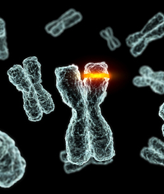Gene Mutation Test Could Aid Esophageal Cancer Diagnosis
New research has identified specific gene mutations that occur in precancerous esophageal lesions, a finding which was then put into use with a simple non-endoscopic test.
New research has identified specific gene mutations that occur in precancerous esophageal lesions

New research has identified specific gene mutations that occur in precancerous esophageal lesions, a finding which was then put into use with a simple non-endoscopic test. These results could improve diagnosis and early treatment of Barrett’s esophagus and esophageal cancer.
“Most epithelial cancers develop gradually from preinvasive lesions,” wrote authors led by Rebecca C. Fitzgerald, MD, of the Medical Research Council cancer unit at the University of Cambridge in the United Kingdom. “However, it is becoming increasingly clear that extensive genomic heterogeneity is present in the majority of advanced cancers.” The researchers thus set out to characterize the ordering of somatic mutations over the course of the generally gradual transition from Barrett’s esophagus to esophageal adenocarcinoma. Their results were published online ahead of print on June 22 in Nature Genetics.
They used whole-genome sequencing and other methods on 112 esophageal adenocarcinomas, and then screened a cohort of 109 biopsies from two key transition points in the malignancy’s natural history (benign metaplastic never dysplastic Barrett’s esophagus and high-grade dysplasia). The findings, the authors wrote, were “striking and unexpected.” They saw a number of mutations, but the mutational frequency was not significantly different between the various time points of disease development.
There was one notable exception, however: TP53 was found to be frequently mutated in high-grade dysplasia and esophageal adenocarcinoma samples, but almost never in never dysplastic Barrett’s samples. The investigators used this result to derive a clinical benefit using a new type of test.
Currently, patients with Barrett’s esophagus undergo regular endoscopic tests to determine risk of progression to malignancy. The new test is non-endoscopic, called the Cytosponge. In an email Fitzgerald described is a small capsule on a string that a patient swallows; the capsule dissolves yielding a spherical sponge that collects cells as it is pulled out using the string. “The whole process takes five minutes,” Fitzgerald said.
Coupled with high throughput sequencing, the test was able to identify TP53 mutations in 19 of 22 individuals with high-grade dysplasia, and no such mutations were seen in other patients.
“The take-home message is that early precancerous lesions-Barrett’s with no dysplasia-have a lot of mutations,” Fitzgerald said. “These are unlikely to be driving disease progression. However, p53 mutations seem to be specific to lesions that are developing into cancer, and we have found a way to detect these on a novel non-endoscopic device.”
The study authors concluded not only that the Cytosponge, along with these results on mutations in esophageal cancer, can aid in diagnosing high-risk individuals, but that the techniques employed in finding those mutations could be used for other epithelial malignancies that could be amenable to early detection.